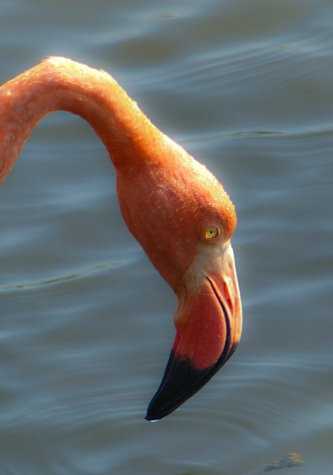We crossed black lava; uneven, jagged and bordered by Opuntia prickly pear cacti with spines worthy of great respect, to arrive on a white sand beach and a rocky intertidal shore. Sally lightfoot crabs and Galapagos marine iguanas stood out; red-on-black, black-on-white. It was a visit of starkness with blasts of color. The tiny lagoon behind the beach had several flamingos sleeping or feeding: add salmon-pink to that list!
The trail of Cerro Dragon leads inland over a rocky path through Palo Santo forest. The understory is made up of glorious Darwin’s cotton, some still with big yellow flowers hoping for a visit from the endemic solitary carpenter bee. Bitterbush, saltbush low and scrubby, but Maytenus and Cordia trees provided a cool shade.
We then spotted some of these impressive, ancient-looking reptiles unique to the islands. The males are bright yellow and orange, while females are slightly smaller and darker. One yawned, despite the fact it was being stared at by 15 humans, some with huge black eyes (camera lenses), just a few feet away. Their innocence still strikes me, officially called “ecological naïveté”. They were under threat in the 1970’s from feral dogs and cats, but with eradication campaigns and control visits from the Galapagos National Park, there is now a healthy population living around this low hill of adequate soil composition for burrows and nesting.
By the time we returned to the National Geographic Endeavour in the late morning, many were more than ready to go snorkeling, including myself! The Guy Fawkes Islets provided us with a new and different deep-water snorkeling experience. They are four small remnants of volcanic tuff cones, so eroded it is hard to imagine their original circular formation. Underwater the drop-off goes to over 200 feet; a cliff that is covered with marine invertebrates such as orange cup corals, sponges, hydroids and tunicates. An octopus showed itself for a while, as it had no-where else to go – escape route blocked by irate damselfish, and a white-tipped reef shark cruised past minding its own business.
I must make mention of the lunch today, as the galley staff and dining room staff put on an outrageous show of traditional Ecuadorian foodstuffs from all regions of the country: ceviche from the coast; grains and legumes from the highlands, fruits from the tropical lowlands. The desserts were over-the-top delicious: three-milk cake, “alfahores” (shortbread cookie sandwiching a caramel filling), figs and cheese, tropical sorbet…wow!
The afternoon was fortunately not strenuous, but consisted of a Zodiac ride along the coast of Santa Cruz and Eden Islets, where sea birds, shorebirds and marine life was searched for and many found. At least that’s what the adults did. Our Junior Naturalists-in-the-making had to pass their Zodiac-driving classes instead. For some reason, it was necessary to have each of them take the tiller more than once to make sure they had it down correctly.
As we left Isla Eden, our guest lecturer on board, Beau Parks working with the Charles Darwin Research Station, gave us a presentation on the head-start program for Darwin’s mangrove finch, a critically endangered species. Without this three-year-old program, this population would have quickly disappeared due to predation by rats and a parasitic fly, both introduced to the islands through anthropogenic means. It is imperative that everyone understand how fragile island ecosystems are, and how quickly and thoroughly they can be disrupted.
By then, the Captain had weighed anchor yet one more time, but this time our intention was to enjoy a sunset circumnavigation of famous Daphne Major, while at the same time, participate in a bit of wine-tasting on the bow. A small volcanic tuffcone, Daphne Major was the location for 30 years of research by Peter and Rosemary Grant and their graduate students from Princeton University. They focused on the three species of Darwin’s finches known to inhabit that one small area in almost complete isolation from the surrounding islands. Such a small population could be watched, banded, measured, and sampled (blood) for generations. The effects of natural selection on these finches were recorded and subsequently became one of the keystone studies in evolutionary biology, world renown.
The weather held out for us. Calm seas and clear skies provided us with the perfect backdrop for portraits, and memorable images for the future, in mind, heart and camera.







